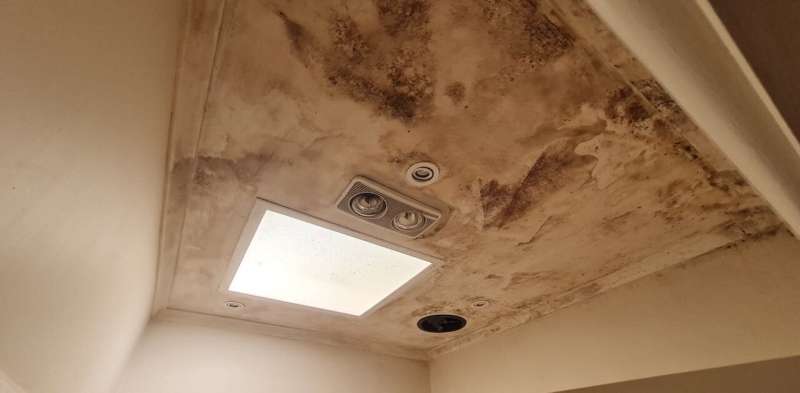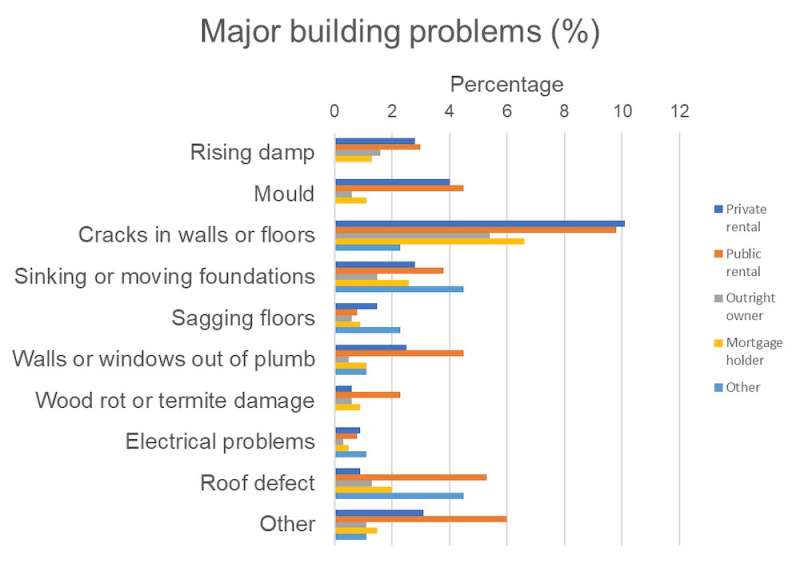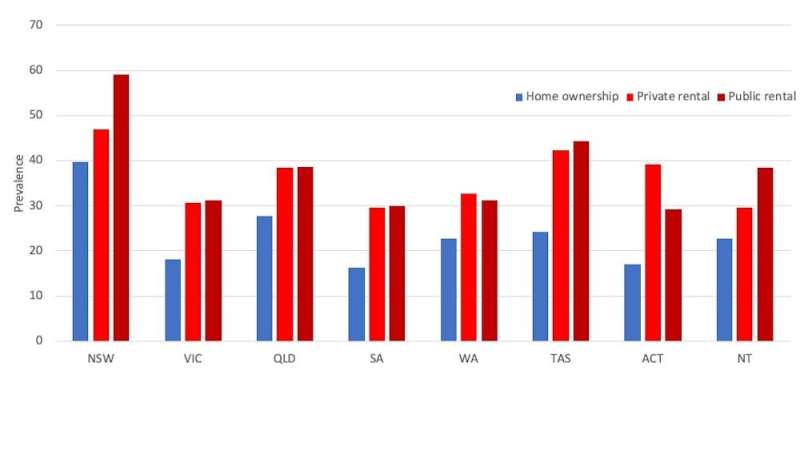This article has been reviewed according to Science X's editorial process and policies. Editors have highlighted the following attributes while ensuring the content's credibility:
fact-checked
trusted source
written by researcher(s)
proofread
Breaking the mold: Why rental properties are more likely to be moldy and what's needed to stop people getting sick

Rental properties are more likely be moldy than other homes. This is a concern as excessive mold growth is known to harm human health.
Once buildings are infested with mold, the difficult and costly issue of remediation arises. Landlords and tenants are caught in the middle of a tussle over who is responsible for fixing the problem. As one Melbourne renter and research participant told our colleague Maria Gatto, during a study validating mold reporting:
"The landlord came around [and] walked [into] every room where there's black mold on the ceiling—like it's freaking [something out of the TV series] Stranger Things—and she's like, "Oh, a little bit of mold in winter, it's very normal, it's fine […] this happens every winter, it's not a big deal.'"
Heading into winter, after three consecutive La Niñas, conditions are ripe for a mega-mold season. Combining our expertise in health, law, building and construction, we examine the problem of mold in homes and offer guidance for both renters and landlords.
Ideal conditions for growth
Mold is a fungal growth that reproduces via tiny airborne particles called spores. When these spores settle on moist, plant-based construction materials such as wood, wallpaper or plasterboard, they can form a new colony.
Growth is more likely when homes are cold, humid, lack air flow, or suffer from water damage. Outbreaks have been reported in flooded parts of southeastern Australia.
So why is the problem of household mold worse in rentals? Weak regulation of tenancy legislation is just one of many factors. Rental properties tend to be poorly maintained, with structural problems such as leaks. Given this, they can be expensive to heat.
How mold makes people sick
The World Health Organization recognizes mold can be harmful.
A 2022 Asthma Australia report revealed people living in moldy homes were more likely to have asthma and allergies. A systematic review of peer-reviewed research found children living in moldy homes were more likely to experience asthma, wheeze and allergic irritation of the eyes, nose, throat and mouth (allergic rhinitis).
Living with mold is a source of stress. People worry about the consequences for their health and there is a growing body of evidence describing the negative mental health effects of moldy, damp homes.
Problems with managing mold in the rental sector
There is a gap between building and residential tenancies legislation. A building deemed to meet the minimum standards of the construction code with respect to mold may not meet the minimum standards for rental. That's because there's ambiguity in the National Construction Code around "minimum standards of health."

For example the Victorian Building Act 1993 contains some provisions for the relevant surveyor to serve a notice on the basis of a health circumstance affecting a user. However, there is no guidance on how to assess the health of the indoor environment, or to deliver a building direction that will address the root cause for mold. This varies by state and territory.
Mold remediation can be costly. A study by Victoria University found half the defects causing mold were water-related. These were more expensive to fix than other problems, by an average of A$7,000.
Each winter, Tenants Victoria deals with a spike in renters seeking legal help to resolve their mold problems. This led to the service launching an annual winter Mold Clinic in 2021.
Despite increased legal protections, renters are still struggling to get mold fixed. For these reasons, many renters find the legal process doesn't offer a solution to their problem, and instead move to a new property, with all its attendant costs and stresses. Others can't afford to leave, or live in social housing with limited transfer options.
Where does the responsibility lie?
Tenancy legislation varies by state and territory. Renters should familiarize themselves with the regulations in their jurisdiction.
In Victoria, residential tenancies legislation has set the criteria that "each room in the rented premises must be free from mold and damp caused by or related to the building structure." Landlords now must disclose if they have treated mold in the past three years.

Similarly, new legislation in Queensland (coming into effect in September) states rental properties should be free from vermin, damp and mold where this is caused by issues with the structural soundness of the property.
In New South Wales, the landlord needs to disclose signs of mold and dampness in the condition report (but not necessarily have fixed it). Mold is not mentioned in the ACT residential tenancies legislation.
For the most part, the responsibility for mold in rental properties lies with landlords if the cause is structural –- for example, if a broken or faulty window frame has let rainwater inside.
Requests for urgent repairs can be accompanied by an assessment report by an occupational hygienist, environmental health professional or expert from the local council. People with an existing health condition such as asthma can include a doctor's report.
What's next?
To achieve change across all relevant domains of regulation, construction, natural disaster response and government policy, we need a sustainable, broad healthy housing agenda in Australia. We also need to consider options for immediate action.
As one Victorian renter noted: "When we buy a car for the purpose of driving on the roads, we're required to get a roadworthy certificate to make sure it's safe, because of the risk to other people […] Ideally it would be great if there was [some] kind of 'rentworthy' certificate […] to demonstrate that the property has been inspected, to identify any structural issues that might affect the tenant's health and well-being. And that that be available to tenants […] before they enter into a lease or before (the property is) even able to be advertised."
This article is republished from The Conversation under a Creative Commons license. Read the original article.![]()

















